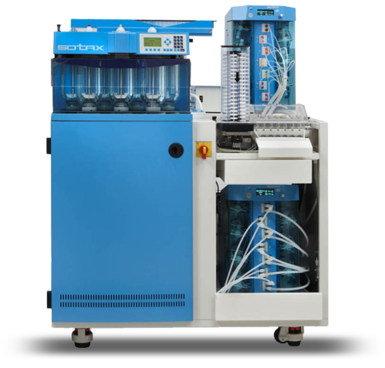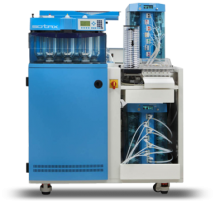AT 70smart Dissolution Bath Design
The core of the AT 70smart is the AT 7smart, a stand-alone bath, which has been adapted to implement full automation and allow simplified throughput, scale-up, and dissolution method transfer.
Hemispheric valves in the vessels allow simultaneous full or partial media changes within individual basket and paddle methods. Furthermore, the valves guarantee fast removal of sinkers, pellet cartridges, and undissolved dosage form components from the vessels at the end of the test followed by rapid cleaning.
The AT 70smart uses the Hollow Shaft™ system, which eliminates probe-sampling effects due to hydro-dynamic disturbances. This design assures a reproducible sample withdrawal at a compliant sampling height.
It also simplifies media half change and media addition in order to change the pH.
The SOTAX AutoCompliance™ (compliance by design) concept with fixed shaft height and vessel autocentering, ensures reproducible and compliant vessel-shaft assembly without any manual adjustment.
Flexibility maximized - suited for all dosage forms
Large inlet dimensions provide for a wide variety of tablet and sinker types to be introduced manually or automatically.
From standard tablets to capsules with large sinkers – the dissolution bath is capable of handling virtually all dosage forms.
Samples are protected from media before test start. As the inlets are closed during the test, media evaporation is prevented.
UV-Vis analysis on the fly
The dissolution software used in the UV-Vis on-line systems gives the lab scientist dissolution results on the fly. From a mono- or multi-wavelength absorbance measurement - compared to a standard value stored or measured - concentration and % dissolved are immediately calculated, stored and reported.
Off-line analysis
Workload increase or method changes often call for maximum flexibility and modular and scalable sample management devices. They also require safe and reproducible collection and storing as well as logical programming. An off-line configuration offers simplicity and flexibility as the samples once stored in glass tubes or LC vials can be conveyed to any kind of analytical device in all kind laboratory set-ups

 SingaporeSG
SingaporeSG ChinaCN
ChinaCN MalaysiaMY
MalaysiaMY IndonesiaID
IndonesiaID MyanmarMM
MyanmarMM


